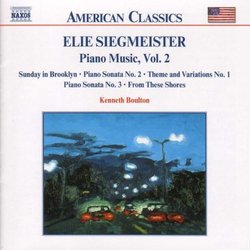| All Artists: Elie Siegmeister, Kenneth Boulton Title: Elie Siegmeister: Piano Music Vol.2 Members Wishing: 0 Total Copies: 0 Label: Naxos American Release Date: 8/31/1999 Genre: Classical Styles: Chamber Music, Historical Periods, Classical (c.1770-1830) Number of Discs: 1 SwapaCD Credits: 1 UPC: 636943902127 |
Search - Elie Siegmeister, Kenneth Boulton :: Elie Siegmeister: Piano Music Vol.2
 | Elie Siegmeister, Kenneth Boulton Elie Siegmeister: Piano Music Vol.2 Genre: Classical
|
Larger Image |
CD Details |
CD ReviewsSome very enjoyable effects here F. Behrens | Keene, NH USA | 09/13/1999 (5 out of 5 stars) "The release by Naxos of Elie Siegmeister's (8.559021) gives us a chance to hear some really enjoyable as opposed to technically interesting keyboard pieces, played here by Kenneth Boulton. As I said in reviewing the first volume, I find such works as his "Piano Sonatas Nos. 2 and 3" more cerebral than inspired, which is what would one expect from works composed respectively in 1964 and 1979. But back in 1946, Siegmeister composed his "Sunday in Brooklyn," which gives us five short tone poems such as " Prospect Park" and "Coney Island." The first is more than passingly reminiscent of "An American in Paris" and great fun. "From These Shores" also offers five portraits, this time of notable Americans: Whitman, Twain, Thoreau, Langston Hughes, and Faulkner. However the dissonance betrays its 1985 origins and is less immediately appealing to those with little sympathy for such a style. The same might be said for his "Theme and Variations, No. 1," although it bears a date back in 1932. Nevertheless many will appreciate what he is doing, although few will play this CD for mood music!" Modern Americana for the Piano Robin Friedman | Washington, D.C. United States | 04/21/2003 (5 out of 5 stars) "ELie Siegmeister (1909-1991) is a too-little known American composer, a student of Nadia Boulanger, who wrote in a variety of musical idioms, ranging from rather traditional, tonal music to modern music full of dissonance and atonality. In all his different styles, Siegmeister maintains, I think, a distinct American voice full of brashness, newness, and hope. His models are in his various styles George Gershwin and Charles Ives, with jazz influences added for good measure. His work deserves to be included in Naxos' "American Classics" series.This disc is the second volume of Siegmeister's piano music recorded by Kenneth Boulton, a specialist in contemporary American piano music. Mr. Boulton also wrote the program notes for the disc which are full and informative.Of the five selections on the CD, there are two suites which are programmatic in character. The first "Sunday in Brooklyn" (1946)describes in a conservative jazzy idiom the bustling mid-20th century American metropolis, (including traffic jams) but includes quiet, domestic scenes as well. This piece was popular when written and deserves to be better known. It is the most accessible piece on this CD.The second suite, "From these Shores" celebrates five American authors: Whitman, Mark Twain, Thoreau, Langston Hughes, and Faulkner. It is modernistic and discordant, but I found it fascinating. To me, the music captures something vivid about the work of each of the five authors it describes, the vision of Whitman, the blusiness of Hughes, the meditative quality of Thoreau. Siegmeister's own to this music, which Boulton summarizes in his notes, are useful here.The remaining three works on this disc are non-programmatic and modernistic in character. There is a sense of verve, of eclat, which comes through this music for me. The early "Theme and Variations No. 1" (1932) is modeled on Beethoven's "32 variations in C minor" and consists of 26 short variations in a work of 10 minutes.The "Piano Sonata No.2" (1964) is a tightly-written single-movement work which undergoes 10 changes of tempo in about 11 minutes. The work is cohesive and taut and distinctively modern.Siegmeister's Piano Sonata No. 3" (1979), written 15 years after the second piano sonata, is in three movements with a mixture of modernist and jazzy passages. It has some traditional aspects, particularly in its form, while remaining unmistakably a work of 20th century modernism.This is a rewarding disc of modern American piano music by an American composer of stature."
|

 Track Listings (15) - Disc #1
Track Listings (15) - Disc #1